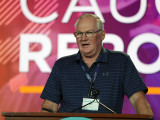NACBE remains committed to our partnership. We do have a partnership with the IBB. We are stronger together.
NACBE Executive Director Ron Traxler says everyone deserves a safe working environment and NACBE exists to facilitate that.
View Photo Gallery (8 photos)
Amid a time of significant change within the Boilermakers union, newly elected International President Tim Simmons set the tone for the 37th MOST National Tripartite Alliance conference held near San Diego Aug. 26-29. Simmons gave a powerful message, emphasizing the union’s perseverance and the need to serve the members.
Simmons acknowledged recent news about indictments handed down by the Department of Justice and the federal investigation into the union, as well as the unprecedented changes in the union’s leadership.
“We have a constitution that directs us…and we have followed the [Boilermakers union] constitution faithfully. We have made other changes, which our members have appreciated, our contractors have applauded and that have strengthened our organization.”
He upheld that the union’s future is secure, while also recognizing that the path forward will likely not be without challenges. Simmons pointed to the Boilermakers’ history in steam and the doom that lay over the union when the locomotive steam engine was replaced by diesel—eliminating the bread-and-butter work of many Boilermakers.
“It was the dedication and adaptability of union Boilermakers that allowed us as an organization to change course and redirect our resources into new industries and technologies,” he said. “That same determination is alive and well today.”
He also reaffirmed his commitment to working together with the International Executive Council, staff, local lodge leaders and members to press forward and ensure Boilermakers continue to be the skilled craftspeople contractors and owners know and trust to man their projects.
“We are here to listen to each other’s concerns and put our heads together to plot a path forward,” Simmons said. “We owe this to you, and we owe it to our brothers and sisters in the field who want to be able to provide for their families.
“The Boilermakers union has faced storms before, and we will do so again—but we will persevere. We were forged by those generations that came before us, and we will build on their foundation to make better the lives of those who come after us.”
Sonya Bohmann, Executive Director of the Construction Industry Alliance for Suicide Prevention, underscored the critical issue of elevated suicide rates within the construction sector. Notably, the industry’s suicide rate is four times higher than the national average, making it the second highest among U.S. industries. Bohmann emphasized the importance of understanding mental health as a continuum, where individuals may fluctuate between thriving and struggling due to various life events.
She advocated for viewing mental health challenges as illnesses, rather than as moral failings. She highlighted that until the 1970s, suicide was considered a crime, leading to stigmatizing language that persists today.
Several factors contribute to the heightened suicide risk in construction, including high stress levels, demanding work conditions, and a culture that often stigmatizes seeking help. Additionally, the industry employs a significant number of veterans, who may face challenges stemming from combat-related traumas, further elevating the risk.
To address these challenges, CIASP is dedicated to creating a zero-suicide industry by providing resources and tools for suicide prevention and mental health promotion in construction. Bohmann advocates for peer-to-peer support, fostering social connectedness, and encouraging leadership to prioritize mental health alongside safety. She also stresses the importance of open conversations about mental health, suggesting that simple actions like checking in with colleagues or sharing supportive messages can make a significant difference.
For immediate assistance, individuals can contact the 988 Suicide & Crisis Lifeline, which offers 24/7 access to trained crisis counselors.
Nuclear energy is gaining momentum on Wall Street, signaling a shift in this long-overlooked sector, according to Hilary Lane, Director of Fuel and Radiation Safety at the Nuclear Energy Institute. With 94 reactors across 53 U.S. sites, nuclear power provides about 18% of the nation’s energy and nearly half of its clean electricity. Its efficiency is notable, with a power capacity factor over 90%, far exceeding wind and solar’s 25-30%.
The recent completion of Vogtle Units 3 and 4 in Georgia, each at 1,100 MW, marks a significant milestone for the industry. Looking ahead, nuclear capacity is expected to triple from 100 gigawatts to 300 gigawatts over the next 25 years, driven by advanced nuclear technologies. These range from micro-reactors to large-scale reactors capable of powering cities.
Beyond electricity, advanced nuclear can produce hydrogen and provide industrial process heat. Sectors like data centers, oil and gas and artificial intelligence are exploring nuclear energy to meet their growing energy needs. Projects such as TerraPower in Wyoming, which is converting coal plants to nuclear, and X-energy in Texas, which is collaborating with Dow Chemical, highlight nuclear’s industrial potential.
Federal support for nuclear is increasing, with new legislation and tax credits boosting the sector. Bipartisan backing at the state level is also rising, with many states lifting restrictions and exploring ways to accelerate nuclear energy’s growth.
MOST Programs Administrator Mark Garrett shared training updates and changes to drug testing and OSHA 10. He said that he’s spoken with apprentice coordinators in different areas and is informed about those who are coming into the union who may already have an OSHA 10 certificate. If he can verify a member has passed OSHA 10, they don’t need to retake it.
“It streamlines the process and gets people to your jobsites,” he said.
Garrett also said that in July, the MOST Board of Trustees decided to remove testing for marijuana metabolites. He said if a contractor or owner requests this testing, it’s still available.
Garrett said the new mental health program introduced last year has received positive feedback. “I feel like we can’t talk enough about the mental health program.”
Caucus reports delivered by chairmen representing each sector of the tripartite alliance detailed opportunities for improvement, but also praised successes. John Burnett with Chevron, chairman of the owners’ caucus, kicked off the reports noting several areas of importance to improve safety: hands-free standard for bolting, rigging training specific to the type of work to be performed, drug testing policies and concerns about opioid use, ongoing focus on significant injuries and fatalities, and attention to detail in permitting.
The owners’ caucus also identified staffing and productivity, quality and access requirements as topics to address.
“We need more up-front discussions about manpower availability and experience, especially at the local level,” Burnett said. “We need more transparency on per diem to obtain quality craftsmen. And contractors should continue to raise the level of expectations. It’s something the owners are passionate about.”
Owners had a frank discussion about quality, manpower, availability and experience. Burnett stressed the need for transparency in communicating needs among the owners, contractors and Boilermakers to ensure the best quality of work is produced.
Reporting for the contractors’ caucus was chairman Mike Bray, Senior Executive Consultant for Riggs Distler and Company, Inc. The caucus homed in on the need to understand referral rules, the need for open solicitation to man smaller work projects and the need for selectivity. Bray said contractors also want to better understand the M.O.R.E. Work Investment Fund—what’s available to help win work and how to go about utilizing the M.O.R.E. Work program.
Training was also tops on their list, and Bray called for more or updated confined space training (some jobsites don’t accept MOST programs’ certification), advanced training on robotics, use and care of cordless tooling, and torquing and tension training. Also, he said, training is needed in new technology.
“With new technology, we really have to train our people to get involved, to get into the scheduling and costing aspects of the business so that we can use Boilermakers on these jobs,” Bray said.
Anthony Howell, AAIP and Executive Director-Construction Sector Operations, represented the labor caucus as chairman.
Dovetailing with earlier reports, he began with the issue of travel cost and expenses Boilermakers incur to man projects, and he explained that being able to use per diem to offset those costs could make a big impact on recruiting.
“It’s the first question they ask before they know anything else about us or the job: What’s the per diem?” he said.
And, he said, the caucus also identified a need for better communication about the M.O.R.E. Work Investment Fund resources.
“I spoke with some of the owners yesterday, and they told me how they appreciate how hard Boilermaker business managers and reps worked to respond to their needs,” he said.
“Anything that can be done to spread out work is good,” Bray said. “Those who are doing that are getting better manpower fulfillment.”
The National Association of Construction Boilermaker Employers is 49 years old and continues to evolve by identifying and solving safety concerns. NACBE Executive Director Ron Traxler detailed programs offered by the organization, which was began as the result of tripartite discussions to address issues.
“We’re like a three-legged stool,” Traxler began. “NACBE remains committed to our partnership. We do have a partnership with the IBB. We are stronger together. We all know that there have been some changes, but that’s what we do, we maximize on our strengths. We are stronger together and we must continue to work together.”
He noted that combined, 417 years of experiences sits on the NACBE Board of Directors. He stressed the importance of being involved in the organization and its programs, especially those involved with safe working conditions.
“Safety is paramount, and we collaborate with MOST to educate and develop programs,” Traxler said. “We all need a safe work environment.”













